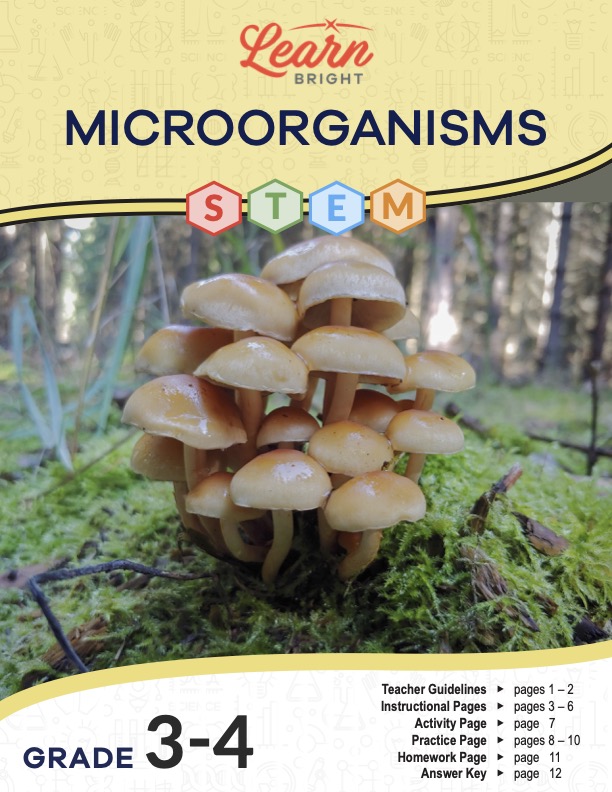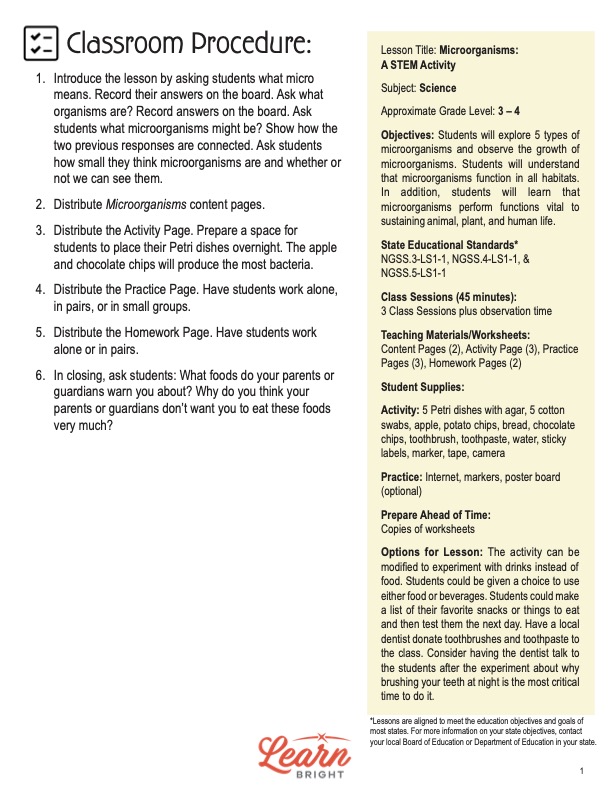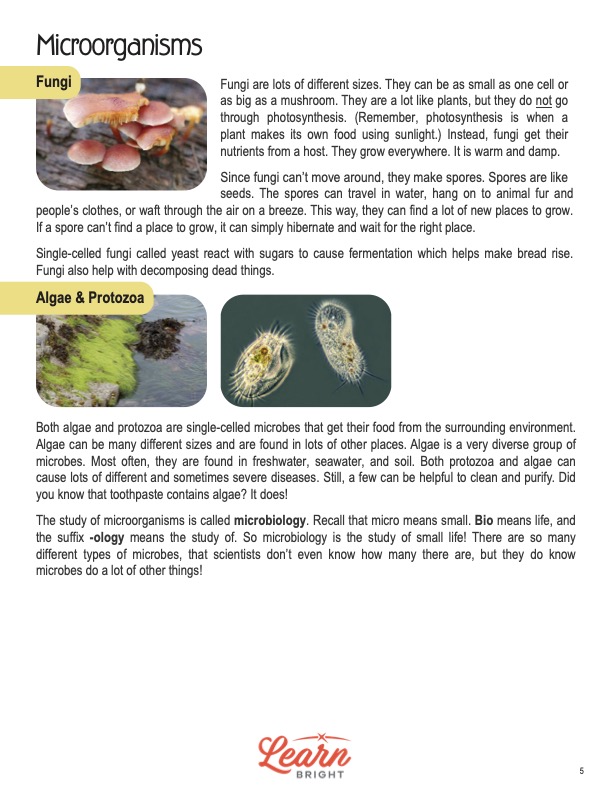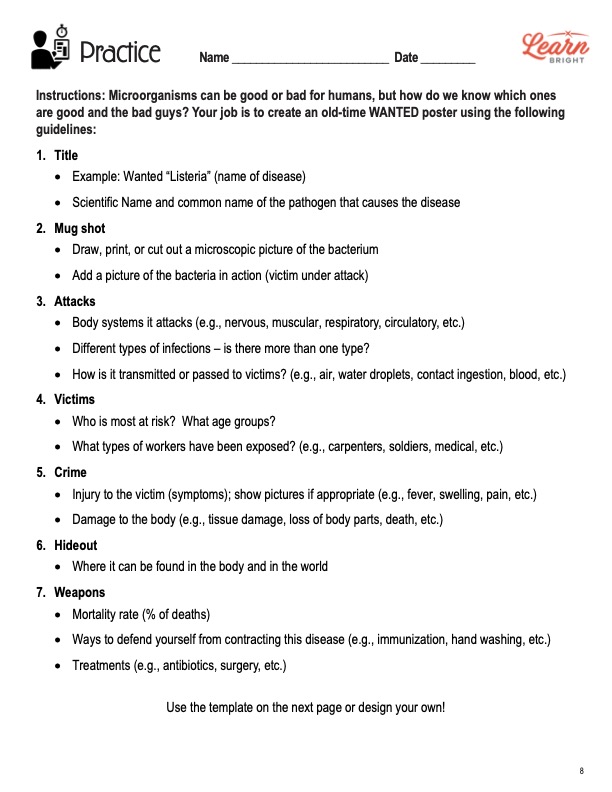Description
What our Microorganisms STEM lesson plan includes
Lesson Objectives and Overview: Microorganisms STEM introduces students to five unique types of living things. Students will observe how these organisms grow and understand their role in the world’s habitats. They will also discover that these living things perform vital functions in sustaining life on Earth. This lesson is for students in 3rd grade and 4th grade.
Classroom Procedure
Every lesson plan provides you with a classroom procedure page that outlines a step-by-step guide to follow. You do not have to follow the guide exactly. The guide helps you organize the lesson and details when to hand out worksheets. It also lists information in the yellow box that you might find useful. You will find the lesson objectives, state standards, and number of class sessions the lesson should take to complete in this area. In addition, it describes the supplies you will need as well as what and how you need to prepare beforehand. For this lesson, you will need Petri dishes with agar, cotton swabs, apples, potato chips, bread, chocolate chips, toothbrushes, water, sticky labels, markers, tape, and cameras.
Options for Lesson
You will find several additional ideas and activities to incorporate into the lesson in the “Options for Lesson” section of the classroom procedure page. A couple ideas relate to the activity portion. For instance, you may modify the activity to experiment with drinks rather than food. Students could also choose whether to use food or beverages. Another option is to let students make a list of their favorite things to eat and test them the following day. You could ask a local dentist to donate toothbrushes and toothpaste to the class. One more option is to have a dentist speak with the students after they perform their experiments about why brushing our teeth at night is the most critical time to do it.
Teacher Notes
The paragraph on this page provides a little more information or guidance on what to expect from the lesson. You can use the blank lines to record any thoughts or ideas you have as you prepare.
MICROORGANISMS STEM LESSON PLAN CONTENT PAGES
What Is a Microorganism?
The Microorganisms STEM lesson plan has three content pages. Just as there are millions of species of plants and animals, there are also millions of various microorganisms. Micro means tiny, and organism means a living creature. Another name for a microorganism is a microbe. Hundreds of microorganisms would be able to fit in the space of a period at the end of a sentence!
There are trillions and trillions and trillions, and even more trillions, of microbes on the planet. There are so many that we can’t even count them all. In fact, they make up the most significant number of living organisms on Earth. They are literally everywhere—from the tip of the North Pole to our eyelashes! Some live inside of animals while others hang out on the surface of doorknobs. Microorganisms exist throughout the entire world in soil, air, water, and other creatures.
Microorganisms include bacteria, viruses, and some types of molds. It may seem like life on Earth would be better without bacteria, viruses, and mold. However, while some are harmful, most microorganisms are good and even essential to life. For example, they help break down waste and help us make bread. In addition, microorganisms can survive in environments where humans cannot.
Even though microorganisms are too small to see with the naked eye, they are still living things. There’s a wide variety of microorganisms and a variety of ways they operate. Some like to work alone, and others clump up into colonies. They can be harmful or helpful to other living organisms depending upon the type. Microbes that cause diseases are called pathogens or germs. Five types of microorganisms include bacteria, viruses, fungi, algae, and protozoa.
Bacteria and Viruses
Bacteria are single-celled organisms that are neither animals nor plants. They are shaped like a sphere, rod, or spiral. A single one is called a bacterium. We can see bacteria when they start to grow in clump-like groups. Bacteria can live anywhere—it doesn’t matter how hot or cold it is. In fact, they even live in our intestines and help us digest food! They have been around for millions of years, and they aren’t going anywhere anytime soon.
Students will learn that bacteria are the world’s best decomposers because they break down dead and decaying organic matter like leaves and insects. Bacteria turn rotting things into nutrients that return to the soil. The nutrients help to provide food for other living things. Most bacteria keep us healthy. We can use good bacteria to make medicine, for instance, and we can find them in some dairy products.
One cool way we can use bacteria is to clean up oil spills. They break down the oil to make the environment healthy again. But not all bacteria are good. Harmful bacteria love dirty places where they can multiply. They reproduce themselves super fast, which causes food to spoil or humans to become sick. When bacteria grow on uncooked meat, it can cause food poisoning.
Viruses are smaller than bacteria. Unlike bacteria, viruses are not technically living things because they cannot survive on their own. They are parasites that need a host (another living thing) to live. Viruses have to get inside a living cell to survive, and once inside a host, they can send directions to the cell to make more viruses. They make so many copies of themselves that the cell will burst and infect other cells around it. Infectious diseases like chickenpox, the flu, and Covid-19 are all viruses. They can spread very quickly and very easily!
Fungi, Algae, and Protozoa
The next type of microorganism students will learn about is fungus. Fungi come in lots of different sizes. They can be as small as one cell or as big as a mushroom. They are a lot like plants, but they do not go through photosynthesis. Instead, fungi get their nutrients from a host. They grow everywhere that it is warm and damp.
Since fungi can’t move around, they make spores, which are kind of like seeds. The spores can travel in water, hang on to animal fur or people’s clothes, or waft through the air on a breeze. This way, they can find a lot of new places to grow. If a spore can’t find a place to grow, it can simply hibernate and wait for the right place. Single-celled fungi called yeast react with sugars to cause fermentation, which is what helps make bread rise. Fungi also help with decomposing dead things.
Both algae and protozoa are single-celled microbes that get their food from the surrounding environment. Algae also comes in many different sizes and exist in lots of other places. It is a very diverse group of microbes. Most often, they are found in freshwater, seawater, and soil. Both protozoa and algae can cause lots of different and sometimes severe diseases. Still, a few can be helpful to clean and purify.
The study of microorganisms is called microbiology. Micro means small, bio means life, and the suffix –ology means the study of. So microbiology is the study of small life! There are so many different types of microbes, that scientists don’t even know how many there are.
MICROORGANISMS STEM LESSON PLAN WORKSHEETS
The Microorganisms STEM lesson plan includes three worksheets: an activity worksheet, a practice worksheet, and a homework assignment. Each one will reinforce students’ comprehension of lesson material in different ways and help them demonstrate when they learned. Use the guidelines on the classroom procedure page to determine when to distribute each worksheet to the class.
MICROORGANISMS STEM ACTIVITY WORKSHEET
Students will get to experiment to see what types of food produce the most mouth bacteria. First, they will set up a control on the first petri dish. After they brush their teeth and rinse with water, they will swab the inside of their cheek. Then they will rub the swab onto the agar in the petri dish gently and spread the saliva in a straight line.
Each student will repeat the swab process after eating various foods—an apple, chips, bread, and chocolate. After each food, they will brush their teeth and rinse with water. At the end, they will respond to the prompts at the bottom of the second worksheet page about the experiment. The last prompt asks them to choose one food item and draw a before and after picture of the petri dish on another sheet of paper.
WANTED POSTER PRACTICE WORKSHEET
The practice worksheet requires students to create a wanted poster using a series of guidelines. Students must include a title, such as “WANTED: Listeria” or both the scientific and common names of the pathogen. They should also include a mug shot. This can be a drawing, printed picture, or cut-out from a magazine.
Other guidelines include information on attacks (such as body system the microorganism attacks), victims, crime, hideout (where to find it in the body or world), and weapons. Weapons would be things like mortality rate, ways to defend against the disease, or treatments.
STORY SPINE HOMEWORK ASSIGNMENT
For the homework assignment, students will write a story about a microbe using a story spine. The microbe can be either the hero or villain. In the first sentence, students must include the type or name of the microbe and provide the setting.
Worksheet Answer Keys
The nature of the assignments for this lesson plan do not necessitate answer keys. Students will use their creativity to complete these worksheets throughout the lesson. You can develop a rubric for grading the assignments if you want to.









